Underdogs in football: How, despite the odds, the sport is unpredictable

Written by :
Matthew Hanssen

Reviewed by :
Heloisa Vasconcelos

Can we measure unpredictability in football ? We collected almost 480,000 matches from more than 800 leagues around the world to try to answer this question.
Using historical odds data from several bookmakers, the objective was to calculate the average for each match in the odds of a home team winning, a draw and a away team winning, and convert these odds into probabilities.
This process allowed us to quantify pre-match outcome expectations and compare them with actual results, providing a solid basis for investigating unpredictability in football.
The first step was to convert odds into probabilities, and to do this, we must calculate the inverse of the odd.
For a team with odds of 9.02, we divide 1 by this value, resulting in 0.1109 or 11.09%. This conversion is essential to understand the perception of chances before the game.
For example, an odd of 2 represents an implied probability of 50%. This quantitative method allows us to assess where and how surprises occurred.
Google News
Want to stay up to date with everything that’s happening in the world of sports betting? Check out the news from Aposta Legal Brasil!
Analysis of results
In 48% of the games analyzed, the winner was the team least likely to win, according to the odds. This fact alone challenges the notion of favoritism, highlighting a fundamental characteristic of football: its unpredictability.
Results dynamics
- Visitors: In 53% of games where the visiting team won, the home team was the favorite, while in only 47% of cases was the winner actually the likely team to win. This indicates that despite the perceived advantage of the visitors, the home advantage plays a crucial role in determining the outcome.
- Draws: In 72% of games that ended in a draw, the home team was the favorite, while in 28% the away team was the favorite (there is also a small, insignificant percentage where a draw was the likely outcome).
- Home teams: As expected, in 84% of the games in which the home team won the match, this result was actually expected. In only 15% of the games, the away team was seen as the favorite before the ball started rolling (1% referred to a likely draw).
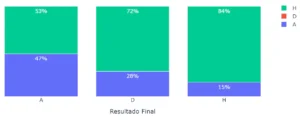
Margin of victory in unlikely outcomes
The distribution of the margin of victory in games with an unlikely winner reveals that most of these encounters are decided by a thread.
In 72% of these cases, the match was decided by a difference of just one goal (examples include results such as 1-0 or 2-1), highlighting how details and moments can change the course of a game.
Furthermore, in 21% of games, the difference was two goals, and in 5%, the difference reached three goals. This analysis highlights not only the competitiveness of football, but also how expectations can be subverted, even in games that at first glance seem lopsided.
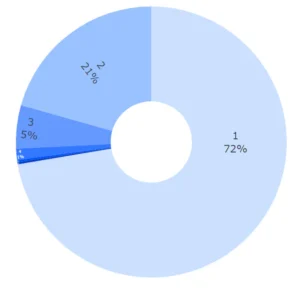
Differences by region
Analysis of the data reveals significant variations in the unpredictability of football results across different countries. This diversity reflects not only the style of play and strategies employed, but also cultural and fan factors that influence team performance.
- Poland: With 41% of games resulting in wins for the team with the least chance, Poland stands out as one of the nations with a high rate of unpredictability. This data suggests fierce competition in the Polish league, where the favorites are often challenged.
- Top-5 European Leagues: France leads the way in terms of unpredictability among the major European leagues, with almost 40% of games ending in unexpected results. This high rate may reflect the competitive nature of Ligue 1, where lower-tier teams have demonstrated an ability to outplay more highly rated opponents. In contrast, Germany has the lowest unpredictability rate, with 37% of games having an unexpected winner, which still reflects a considerable degree of competitiveness in the Bundesliga.
- Norway: With an unpredictability rate of just 32%, Norway was identified as the most predictable country. This result may indicate a more defined hierarchy of teams in the Norwegian league, where favorites tend to confirm their expectations more often.

Differences by competition
Unpredictability also varies significantly between different leagues and competitions, highlighting how the structure of each tournament and the level of teams involved can influence outcomes.
- Major League Soccer (MLS): With a 42% rating, MLS is the most unpredictable league. This high level of unexpected results can be attributed to the competition format and the league’s fairness policies, such as the salary cap and draft system, which aim to maintain a competitive balance between teams.
- League 1: Very close to MLS in terms of unpredictability, League 1 also has a high rate of unexpected results. This fact highlights the competitiveness of the French league, where even teams considered underdogs are capable of surprising.
- Premier League: Surprisingly, the Premier League was identified as the most predictable league in the top five, a figure that may reflect the strength and consistency of the league’s top teams, who often manage to outperform their opponents as expected.
- Euro Cup: Among the competitions analyzed, the Euro Cup stood out as the most predictable competition, with only 25% of matches ending in unexpected results. This may be due to the format of the tournament and the presence of highly qualified national teams, where differences in skill and preparation are often evident.
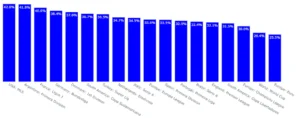
Club performance
Analysing clubs across our decade of data reveals fascinating insights into teams’ ability to overcome the odds or falter under the pressure of favouritism.
![]()
“ This data not only highlights the competitive dynamism within leagues, but also offers insight into the consistency, strategy, and perhaps the mindset of teams and their coaches in different contexts. ”
 Matthew Hanssen
Matthew Hanssen
Data Analysis Specialist
Teams that surprise the most
- AZ Alkmaar: Leading the way as the club that most surprises, AZ Alkmaar have won 21% of the matches in which they have been considered underdogs. This success rate is remarkable and reflects the team’s resilience and tactical ability to overcome adverse expectations.
- River Plate: Following closely behind, Argentina’s River Plate have demonstrated their ability to defy the odds with a 20% success rate in games they were unlikely to win, reinforcing their reputation as a team capable of exceptional performances at critical moments.
- Atletico Madrid and others: Atletico Madrid, at 14%, followed by Manchester City (9%), Arsenal (8%), and Ajax (5%), also showed significant ability to turn games around against the odds. Chelsea and Liverpool, at just 2% and 3% respectively, were less likely to surprise as underdogs, which may reflect the consistency of performance expected of top teams.
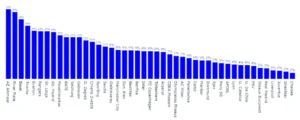
Teams that disappoint the most
- University of Chile: At the opposite extreme, the University of Chile stands out for losing 35% of the matches in which it was considered favorite, an indication that being the favorite does not always translate into performance on the field.
- Ajax: With a surprisingly high 27% loss rate as favourites, Ajax demonstrate vulnerabilities that belie their historic European reputation.
- Other big clubs: Bayern Munich (16%), Manchester United (15%), Chelsea (14%), Liverpool (13%), Manchester City (12%), Real Madrid (11%), Milan (10%), Juventus (7%), and Arsenal (4%) complete the list of teams that, although they often dominate their leagues, have also experienced unexpected defeats when they were most expected to win.
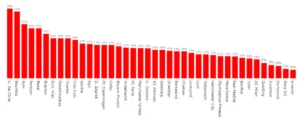
Iconic games
The decade of analysis has revealed a series of matches that exemplify the unpredictability and excitement that football can offer.
These games not only surprised spectators, but also defied odds-based expectations, reiterating that in football, statistics and probabilities never guarantee the outcome.
Real Madrid vs. Schalke (Champions League, 2015)
On a night that went down in history, Schalke beat Real Madrid 4-3 at the Santiago Bernabéu, a match where the odds of 13 suggested an 83% chance of Real Madrid winning. Despite the defeat, Real Madrid advanced to the next round in the second leg, demonstrating the complexity of knockout competitions and the ability to overcome obstacles.
Barcelona vs. Rubin Kazan (2009)
Rubin Kazan, with an average odd of 22, translating into just a 4% chance of victory, shocked the football world by defeating Guardiola’s Barcelona at Camp Nou by 2-1.
Real Madrid vs. Recreativo Huelva (2006)
In another surprising setback for Real Madrid, the team lost 3-0 to Recreativo Huelva, a small club that faced almost an 80% chance of defeat.
Spain vs. Switzerland (World Cup, 2010)
In the 2010 World Cup, Spain, who would go on to win that edition, faced an unexpected 1-0 defeat against Switzerland in the first round, despite having almost an 80% chance of winning.
Bolivia vs. Argentina (2009 World Cup Qualifiers)
Bolivia’s 6-1 victory over Argentina, a team that had a 60% chance of winning, was one of the most surprising results in World Cup qualifying. The game highlighted how external conditions, such as altitude, can significantly influence performance.
Real Madrid vs. Bayern Munich (Champions League, 2014)
Finishing with an impressive 4-0 away win for Real Madrid against Bayern Munich, despite having only a 20% chance of winning, this result demonstrated Real Madrid’s ability to perform under pressure and defy the odds at a crucial stage of the competition.
Conclusion
As we can see, in almost half of the games analyzed the result contradicted the probabilities indicated by the odds, reiterating the fact that, in football, what is expected does not always come true.
The variation in the unpredictability of results between different countries and competitions reveals how cultural, strategic and fan factors influence the game, making it even more unpredictable and exciting.
Clubs like AZ Alkmaar and River Plate have proven to be masters at exceeding expectations, while others, like Universidad de Chile and Ajax, have often failed to live up to their role as favourites.
Iconic games, such as Rubin Kazan’s shock victory over Barcelona, serve as vivid reminders that in football, anything is possible.
